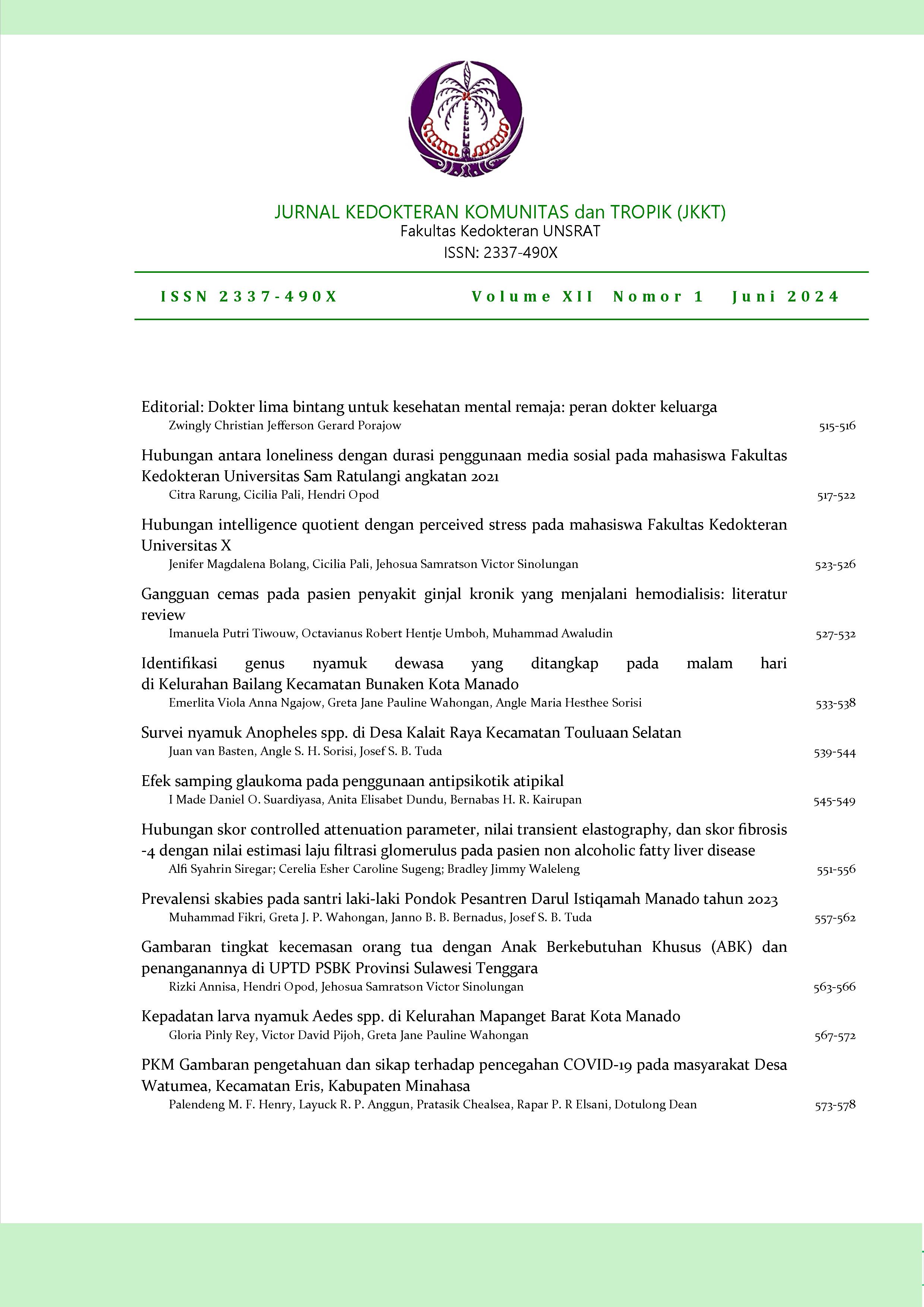The correlation between controlled attenuation parameter score, transient elastography value, and fibrosis-4 score with estimated value of glomerulus filtration rate in non-alcoholic patients fatty liver disease
Keywords:
CAP score, TE score, FIB-4 score, eGFRAbstract
Background: Non-Alcoholic Fatty Liver Disease (NAFLD) is one of the most common chronic liver diseases and has become a health burden throughout the world over the last two decades. Hypertension, dyslipidemia, obesity, and insulin resistance are considered risk factors for PGK that overlap with the metabolic comorbidity of NAFLD. Several studies reported that the prevalence and risk of PGK events increased significantly in NAFLD patients compared with patients without NAFLD.
Aim: To determine the relationship between controlled attenuation parameter scores, transient elastography, and FIB-4 scores with eGFR values in NAFLD patients.
Methods: This was an analytical study with a retrospective approach and used a cross-sectional design. The subjects were taken using consecutive sampling technique. Data collection on CAP scores, TE scores, FIB-4 scores, and eGFR was carried out by looking at the patients' medical records. In this study, the Pearson correlation statistical test was used.
Result: Correlation test results between CAP scores and eGFR showed a significant positive correlation (r=0.296; p=0.031), between TE scores and eGFR showed a non-significant positive correlation (r=-0.093; p=0.509), and FIB-4 score with eGFR showed a significant negative correlation (r=-0.281; p=0.042).
Conclusion: There is a significant positive correlation between the CAP score and eLFG, a non-significant positive correlation between the TE score and eGFR, and a significant negative correlation between the FIB-4 score and eGFR.
Keywords: CAP score, TE score, FIB-4 score, eGFR
References
Pouwels S, Sakran N, Graham Y, et al. Non-alcoholic fatty liver disease (NAFLD): a review of pathophysiology, clinical management and effects of weight loss. BMC Endocr Disord. 2022;22(1):63. Published 2022 Mar 14. doi:10.1186/s12902-022-00980-1
Kuma A, Mafune K, Uchino B, Ochiai Y, Miyamoto T, Kato A. Potential link between high FIB-4 score and chronic kidney disease in metabolically healthy men. Sci Rep. 2022;12(1):16638. Published 2022 Oct 5. doi:10.1038/s41598-022-21039-0
Sun W, Cui H, Li N, et al. Comparison of FIB-4 index, NAFLD fibrosis score and BARD score for prediction of advanced fibrosis in adult patients with non-alcoholic fatty liver disease: A meta-analysis study. Hepatol Res. 2016;46(9):862-870. doi:10.1111/hepr.12647
Lorée H, Bastard C, Miette V, Sandrin L. Vibration-guided transient elastography: a novel Fibroscan® examination with improved guidance for liver stiffness measurement. Ultrasound Med Biol. 2020;46(9):2193-2206. doi:10.1016/j.ultrasmedbio.2020.04.010
Afdhal NH. Fibroscan (transient elastography) for the measurement of liver fibrosis. Gastroenterol Hepatol (N Y). 2012;8(9):605-607.
Surya AM, Pertiwi D, Masrul M. Hubungan protein urine dengan laju filtrasi glomerulus pada penderita penyakit ginjal kronik dewasa di RSUP Dr. M. Djamil Padang tahun 2015-2017. J Kesehat Andalas. 2018;7(4):469-74. doi: http://dx.doi.org/10.25077/jka.v7i4.903
Kaufman DP, Basit H, Knohl SJ. Physiology, Glomerular Filtration Rate. In: StatPearls. Treasure Island (FL): StatPearls Publishing; 2023.
European Association for the Study of the Liver (EASL); European Association for the Study of Diabetes (EASD); European Association for the Study of Obesity (EASO). EASL-EASD-EASO Clinical Practice Guidelines for the management of non-alcoholic fatty liver disease. J Hepatol. 2016;64(6):1388-1402. doi:10.1016/j.jhep.2015.11.004
Liu Z, Jiang Y, Yuan H, et al. The trends in incidence of primary liver cancer caused by specific etiologies: Results from the Global Burden of Disease Study 2016 and implications for liver cancer prevention. J Hepatol. 2019;70(4):674-683. doi:10.1016/j.jhep.2018.12.001
Chen PC, Kao WY, Cheng YL, et al. The correlation between fatty liver disease and chronic kidney disease. J Formos Med Assoc. 2020;119(1 Pt 1):42-50. doi:10.1016/j.jfma.2019.02.010
Jang HR, Kang D, Sinn DH, et al. Nonalcoholic fatty liver disease accelerates kidney function decline in patients with chronic kidney disease: a cohort study [published correction appears in Sci Rep. 2021 May 21;11(1):11139]. Sci Rep. 2018;8(1):4718. Published 2018 Mar 16. doi:10.1038/s41598-018-23014-0
Ramadhan Z, Rasyid H, Bakri S, et al. Mon-267 relationship between liver fibrosis and chronic kidney disease in non-alcoholic fatty liver disease subjects. Kidney International Reports. 2019;4(7, Supplement):S408. doi:10.1016/j.ekir.2019.05.1071
Kasim H, Zatalia SR, Rasyid H, Bakri S, Parewangi ML, Akil F, Seweng A. Correlation between non-alcoholic fatty liver and chronic kidney disease. The Open Urology & Nephrology Journal. 2020 Feb 12;13(1):1-4.
Ahn AL, Choi JK, Kim MN, et al. Non-alcoholic fatty liver disease and chronic kidney disease in Koreans aged 50 years or older. Korean J Fam Med. 2013;34(3):199-205. doi:10.4082/kjfm.2013.34.3.199
Alqahtani SA, Schattenberg JM. NAFLD in the elderly. Clin Interv Aging. 2021;16:1633-1649. Published 2021 Sep 13. doi:10.2147/CIA.S295524
Downloads
Published
How to Cite
Issue
Section
License
Copyright (c) 2024 Alfi Syahrin Siregar, Cerelia Esher Caroline Sugeng, Bradley Jimmy Waleleng

This work is licensed under a Creative Commons Attribution-NoDerivatives 4.0 International License.


